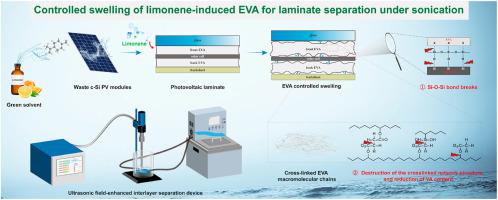当前位置:
X-MOL 学术
›
J. Clean. Prod.
›
论文详情
Our official English website, www.x-mol.net, welcomes your feedback! (Note: you will need to create a separate account there.)
Effective decapsulation method for photovoltaic modules: Limonene-induced EVA controlled swelling under sonication and debonding mechanism analysis
Journal of Cleaner Production ( IF 11.1 ) Pub Date : 2024-03-25 , DOI: 10.1016/j.jclepro.2024.141917 Rui Min , Weikai Deng , Zhi Wang , Tao Qi , Zhihan Zhang , Wanhai Xiao , Guoyu Qian , Dong Wang
Journal of Cleaner Production ( IF 11.1 ) Pub Date : 2024-03-25 , DOI: 10.1016/j.jclepro.2024.141917 Rui Min , Weikai Deng , Zhi Wang , Tao Qi , Zhihan Zhang , Wanhai Xiao , Guoyu Qian , Dong Wang

|
Waste crystalline silicon (c-Si) solar cells are rich in metal resources. The detachment of ethylene-vinyl acetate (EVA) copolymer is a critical step in the recycling of end-of-life (EoL) c-Si photovoltaic (PV) modules, but a clean and high-efficiency adhesive removal method is absent. In this study, we presented a green solvent-based approach using limonene with ultrasound assistance for the efficient delamination of EVA from c-Si PV modules. By adjusting the concentration of limonene solution, the degree of swelling of EVA was effectively controlled, reducing the risk of battery damage caused by uneven swelling. The application of an ultrasonic physical field to the swelling system expedited the diffusion and penetration of the swelling agent between the EVA layers, while simultaneously supplying energy for the fracture of cross-linking bonds. Under the optimized laboratory-scale condition (70 °C, 0.5 h and 0.1 M limonene), complete separation of the glass and backsheet from the EVA bonding layer was achieved. The intact c-Si solar cells thus have the potential to be fully recovered in subsequent processes. FT-IR tests and density functional theory (DFT) simulations confirmed that under ultrasound conditions, limonene molecules selectively attacked crosslinking bridges and side chains of ethyl vinyl acetate in the EVA molecular chain. This induced the breakdown of the EVA crosslinked network structure, resulting in a reduction in adhesive strength and ultimately achieving interlayer separation in 20min. The findings of this study provide theoretical support and technical insights for the clean and efficient recycling of PV modules.
中文翻译:

光伏组件的有效脱封装方法:柠檬烯诱导的 EVA 在超声处理下控制膨胀和脱粘机理分析
废弃晶体硅(c-Si)太阳能电池蕴藏着丰富的金属资源。乙烯-醋酸乙烯酯(EVA)共聚物的剥离是报废(EoL)晶硅光伏(PV)组件回收的关键步骤,但目前缺乏清洁、高效的粘合剂去除方法。在这项研究中,我们提出了一种基于绿色溶剂的方法,使用柠檬烯并在超声波辅助下有效地将 EVA 从 c-Si 光伏组件中分层。通过调节柠檬烯溶液的浓度,有效控制EVA的溶胀程度,降低因溶胀不均匀而导致电池损坏的风险。将超声波物理场应用于溶胀系统,加速了溶胀剂在EVA层之间的扩散和渗透,同时为交联键的断裂提供能量。在优化的实验室规模条件(70℃、0.5小时和0.1M柠檬烯)下,实现了玻璃和背板与EVA粘合层的完全分离。因此,完整的晶硅太阳能电池有可能在后续工艺中完全恢复。 FT-IR测试和密度泛函理论(DFT)模拟证实,在超声条件下,柠檬烯分子选择性地攻击EVA分子链中乙基醋酸乙烯酯的交联桥和侧链。这导致EVA交联网络结构的破坏,导致粘合强度降低,最终在20分钟内实现层间分离。该研究结果为光伏组件清洁高效回收利用提供了理论支持和技术启示。
更新日期:2024-03-25
中文翻译:

光伏组件的有效脱封装方法:柠檬烯诱导的 EVA 在超声处理下控制膨胀和脱粘机理分析
废弃晶体硅(c-Si)太阳能电池蕴藏着丰富的金属资源。乙烯-醋酸乙烯酯(EVA)共聚物的剥离是报废(EoL)晶硅光伏(PV)组件回收的关键步骤,但目前缺乏清洁、高效的粘合剂去除方法。在这项研究中,我们提出了一种基于绿色溶剂的方法,使用柠檬烯并在超声波辅助下有效地将 EVA 从 c-Si 光伏组件中分层。通过调节柠檬烯溶液的浓度,有效控制EVA的溶胀程度,降低因溶胀不均匀而导致电池损坏的风险。将超声波物理场应用于溶胀系统,加速了溶胀剂在EVA层之间的扩散和渗透,同时为交联键的断裂提供能量。在优化的实验室规模条件(70℃、0.5小时和0.1M柠檬烯)下,实现了玻璃和背板与EVA粘合层的完全分离。因此,完整的晶硅太阳能电池有可能在后续工艺中完全恢复。 FT-IR测试和密度泛函理论(DFT)模拟证实,在超声条件下,柠檬烯分子选择性地攻击EVA分子链中乙基醋酸乙烯酯的交联桥和侧链。这导致EVA交联网络结构的破坏,导致粘合强度降低,最终在20分钟内实现层间分离。该研究结果为光伏组件清洁高效回收利用提供了理论支持和技术启示。



























 京公网安备 11010802027423号
京公网安备 11010802027423号